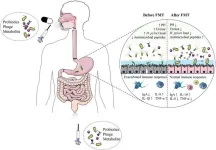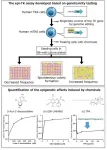(Press-News.org) Everyone wants good quality healthcare, but what exactly is quality and how do you measure it?
Is it to do with the waiting time for home care services? Or how many nursing home residents have had medical supervision in the past year? Or whether the medication lists have been checked recently?
“These are important aspects that are all worth monitoring. The problem is that quality cannot be easily reduced to a quantifiable value,”said Randi Olsson Haave, an assistant professor and PhD research fellow at the Norwegian University of Science and Technology (NTNU) in Gjøvik.
"See me as a person"
Haave is in the process of completing a PhD on quality in municipal health and care services in Norway, and the methods used to monitor it.
“What particularly stands out in my research is how much being seen and treated as a person impacts the experience of quality,” she explained.
Or as one nursing home resident expressed it in one of Haave's research interviews:
“Please, stroke my cheek – see me as a person. I think it is really important. It almost brings tears to my eyes when I talk about it, because it means so much. If the [caregiver] comes in stressed, it makes me ten times more stressed. I immediately feel my oxygen intake drop. There is something about a person who sees you, the energy they give you. It means so much when you have breathing problems, like I do.”
Haave explains that many of the users and residents she interviewed emphasized the importance of interpersonal relationships.
“It could be staff who were good at giving them their attention and creating good moments, or staff who were open and showed understanding. These moments helped them feel safe and cope with everyday life,” said the researcher.
One resident Haave interviewed compared it to a kind of medicine:
“There are some [caregivers] here who are like rays of sunshine. It is like being given a magic pill every time they walk through the door.”
A lot remains unknown about quality
The starting point for Haave’s research is that a lot remains unknown about the quality of municipal health and care services. This is despite the fact that municipalities have been required to report annually to national authorities on 32 different quality indicators for over ten years.
“On the one hand, there is broad agreement that we need good ways to monitor the quality of healthcare services. On the other hand is the question of how best to do it,” said Haave.
Currently, quality indicators are used to do this. According to the Norwegian Directorate of Health, a quality indicator is an indirect measurement, a pointer, that says something about the quality of the area being measured.
“An example of quality indicators in the municipal health and care services could be the time it takes from a decision on home care services being made to the users receiving the service,” explained Haave.
Still a lot of uncertainty
Haave explains that quality indicators are meant to contribute to transparency regarding the quality of the services provided.
“The results are intended to provide the authorities with a basis for prioritization and should serve as a starting point for improvement work both nationally and locally. They are also intended to provide residents, users and relatives with information about the quality of the services,” said Haave.
There is something about a person who sees you, the energy they give you. It means so much when you have breathing problems, like I do.
“Currently, there is still a great deal of uncertainty about the results, both locally and nationally. This is due to a combination of municipal mergers and different registration practices,” Haave said
As mentioned earlier, Haave’s research also highlights a gap between what the quality indicators measure when it comes to healthcare and what those who receive and provide care actually describe as good care.
Residents, users and relatives should be heard
Far too little is known about how those who receive care and treatment experience them, Haave says.
"None of the quality indicators used today measure the experience of or satisfaction with the care provided. Municipalities are required to gather this knowledge by asking residents, users and their relatives,” said Haave.
Unfortunately, it turns out that many years can pass between each time municipalities collect this type of feedback, and when they do, it often happens through questionnaires that must be either mailed or submitted electronically.
“There are many people who are simply unable to do that. Many need help when answering these questionnaires, and as a result, the response rate is low,” Haave said.
She believes that Norway needs to use other methods to a greater extent in order to document the quality of municipal health and care services.
Greater focus on the actual experience of care
Although the methods for monitoring the quality of health and care services have problematic blind spots, Haave does not believe the solution is to get rid of them.
The nurses and healthcare professionals I have interviewed want us to continue using quality indicators. They say the indicators provide them with important frameworks and goals. But they also emphasize that the indicators fail to provide a sufficiently accurate picture of the quality of the services they provide,” said Haave.
Her recommendation is therefore clear:
“Greater focus must be placed on what the indicators currently fail to measure, namely the actual experience of treatment and care. To achieve this, we must also develop and use other methods to document quality.”
References: Olsson Haave, R., Skinner, M.S., Obstfelder, A. and Melby, L. (2025), ‘See Me as a Person’: A Qualitative Study of Long-Term Care Recipients Perceptions of High-Quality Care. Journal of Clinical Nursing. https://doi.org/10.1111/jocn.17646
Olsson Haave, R., Nakrem, S. and Melby, L. (2024). Healthcare professionals’ experience with nutritional care beyond formal quality systems - A qualitative study. International Journal of Nursing Studies, 160, 104860. https://doi.org/10.1016/j.ijnurstu.2024.104860
END
Patients' experience of healthcare should be a greater part of assessing quality
Responding to patients and creating caring moments are just as important as checking medication lists or taking vital signs, especially for the elderly
2025-04-10
ELSE PRESS RELEASES FROM THIS DATE:
Tsinghua University Press and ResearchGate expand Journal Home partnership
2025-04-10
Beijing (China) and Berlin (Germany) April 10, 2025 - Tsinghua University Press (TUP), the leading university press in China, and ResearchGate, the professional network for researchers, has announced an expansion of its Journal Home partnership, which was the first of its kind with a Chinese publisher last year. This expansion more than doubles TUP’s coverage, now including 11 open access titles.
Since 1980, TUP has maintained a strong presence in China’s higher education, science, and technology sectors. The expanded partnership will increase the visibility of 10,000+ research articles, spanning nano research, AI, computing, ...
Therapy-related b-lymphoblastic leukemia following treatment for multiple myeloma with unusual surface light chain expression: a case report
2025-04-10
Background
Therapy-related B-lymphoblastic leukemia (B-ALL) following treatment for multiple myeloma is a rare occurrence. Despite its rarity and the lack of recognition by the World Health Organization as a distinct disease entity, previous publications indicate its possible emergence following myeloma treatment.
Case presentation
The patient is a 65-year-old gentleman with a history of IgG kappa multiple myeloma, status post multiple lines of therapy. The patient presented with a fever, and a complete blood count showed cytopenia. Bone marrow morphologic evaluation revealed numerous blasts. ...
Poo-romising frontier in fecal microbiota transplantation
2025-04-10
Helicobacter pylori (H. pylori) is a widespread bacterial infection associated with gastritis, peptic ulcers, and gastric cancer. While conventional antibiotic-based treatments have been the gold standard for eradication, their efficacy has been steadily declining due to the alarming rise in antibiotic resistance. This has spurred interest in alternative therapies, one of which is fecal microbiota transplantation (FMT).
FMT is a novel therapeutic approach that involves transferring microbiota from a healthy donor to a patient’s ...
A new approach to differentiating large granular lymphocytic leukemias and their mimics in light of current updates in the 5th Edition of the WHO Classification
2025-04-10
Large granular lymphocytic leukemias (LGLLs) are a heterogeneous group of rare chronic lymphoproliferative disorders characterized by the clonal proliferation of cytotoxic lymphocytes. Among them, T-cell LGLL (T-LGLL) and NK-cell LGLL (NK-LGLL) are the most prominent. Due to overlapping morphological, clinical, and immunophenotypic characteristics, distinguishing these disorders from related entities such as T-prolymphocytic leukemia (T-PLL), adult T-cell leukemia/lymphoma (ATLL), Sézary syndrome (SS), and aggressive NK-cell leukemia (ANKL) presents a significant diagnostic challenge. This review integrates recent molecular insights and updates from the WHO 5th edition ...
Simple and cost-effective reporter assay for evaluating chemical-induced epigenetic changes
2025-04-10
Chemicals used as food preservatives, flavoring agents, dyes, pesticides, cosmetics, cleaners, and other industrial materials are being increasingly recognized as a health hazard. Their rampant use has led to an increase in the prevalence of various chemical toxicity-induced diseases, including hormonal disruption, cancer, neurological disorders, skin conditions, and occupational poisoning. Numerous chemicals are known to trigger “carcinogenesis” or cancer development by exerting genotoxic effects (direct or indirect interference with DNA replication and damage repair processes ...
Scientists say the “plant world” needs to come out and claim its place at the One Health table
2025-04-10
Scientists writing a policy forum article in the CABI One Health journal say the “plant world” needs to come out and claim its place at the One Health table as part of a desire to break down barriers that currently limit true cross-domain integration.
The researchers say that while plant health is increasingly recognized as a vital part of One Health, it lacks recognition and – historically focussed on health service provision, zoonotic diseases and antimicrobial resistance – One Health overlooks plant health in strategic plans.
They add that cross-sectoral approaches, core to One Health, are already used ...
A new tool to improve lives after brain injury is underway at The University of Texas at San Antonio
2025-04-10
Traumatic brain injury (TBI) is a serious issue affecting thousands of people in the U.S. every year. For military service members, the impact is even more profound. Since 2000, over 492,000 cases of TBI have been reported, making it one of the defining injuries of modern warfare, according to the U.S. Department of Defense. Many veterans have experienced multiple TBIs, raising concerns about long-term effects on brain health. Given the subjective and nonspecific nature of symptom presentation, treatment and prognosis can be difficult.
Researchers ...
Guinea pigs: A promising animal model to study the human embryo
2025-04-10
The first few days of a human embryo’s development, known as pre-implantation, are important. It’s when the first cells are formed, and these decide if the embryo can survive, how it will implant in the womb and how the tissues of the fetus will develop.
Today there are still logistical, ethical and legal limitations to using human embryos for research purposes, so scientists use alternative models including stem cell-based and animal models.
In a new study published in Nature Cell Biology, Sophie Petropoulos, a researcher ...
The rise of "gut feelings" in US political rhetoric
2025-04-10
Discussion of "alternative facts" has gained sad notoriety in US politics. Yet the question has been around much longer: How do people conduct political debates – is the focus more on facts or personal opinions? A team of international researchers led by the Cluster of Excellence "The Politics of Inequality" looked into the matter. The researchers examined political rhetoric in eight million speeches by members of the US Congress between 1879 and 2022 to see if the focus of their language was more on data and facts or personal convictions and subjective interpretations.
The team noticed a significant decline in the use of evidence-based political ...
How mothers adapt to the metabolic demands of nursing
2025-04-10
Nursing poses major metabolic demands on mothers, to which they respond by eating more and saving energy to sustain milk production. There are significant hormonal changes during lactation, but how they lead to metabolic adaptations in nursing mothers remained unclear. In this study, which appeared in Nature Metabolism, leading researchers at Baylor College of Medicine and Pennington Biomedical Research Center uncovered a mechanism that connects prolactin, estrogen, the brain and metabolic adaptations during lactation.
“We worked with animal models to investigate ...
LAST 30 PRESS RELEASES:
Tracing the quick synthesis of an industrially important catalyst
New software sheds light on cancer’s hidden genetic networks
UT Health San Antonio awarded $3 million in CPRIT grants to bolster cancer research and prevention efforts in South Texas
Third symposium spotlights global challenge of new contaminants in China’s fight against pollution
From straw to soil harmony: International team reveals how biochar supercharges carbon-smart farming
Myeloma: How AI is redrawing the map of cancer care
Manhattan E. Charurat, Ph.D., MHS invested as the Homer and Martha Gudelsky Distinguished Professor in Medicine at the University of Maryland School of Medicine
Insilico Medicine’s Pharma.AI Q4 Winter Launch Recap: Revolutionizing drug discovery with cutting-edge AI innovations, accelerating the path to pharmaceutical superintelligence
Nanoplastics have diet-dependent impacts on digestive system health
Brain neuron death occurs throughout life and increases with age, a natural human protein drug may halt neuron death in Alzheimer’s disease
SPIE and CLP announce the recipients of the 2025 Advanced Photonics Young Innovator Award
Lessons from the Caldor Fire’s Christmas Valley ‘Miracle’
Ant societies rose by trading individual protection for collective power
Research reveals how ancient viral DNA shapes early embryonic development
A molecular gatekeeper that controls protein synthesis
New ‘cloaking device’ concept to shield sensitive tech from magnetic fields
Researchers show impact of mountain building and climate change on alpine biodiversity
Study models the transition from Neanderthals to modern humans in Europe
University of Phoenix College of Doctoral Studies releases white paper on AI-driven skilling to reduce burnout and restore worker autonomy
AIs fail at the game of visual “telephone”
The levers for a sustainable food system
Potential changes in US homelessness by ending federal support for housing first programs
Vulnerability of large language models to prompt injection when providing medical advice
Researchers develop new system for high-energy-density, long-life, multi-electron transfer bromine-based flow batteries
Ending federal support for housing first programs could increase U.S. homelessness by 5% in one year, new JAMA study finds
New research uncovers molecular ‘safety switch’ shielding cancers from immune attack
Bacteria resisting viral infection can still sink carbon to ocean floor
Younger biological age may increase depression risk in older women during COVID-19
Bharat Innovates 2026 National Basecamp Showcases India’s Most Promising Deep-Tech Ventures
Here’s what determines whether your income level rises or falls
[Press-News.org] Patients' experience of healthcare should be a greater part of assessing qualityResponding to patients and creating caring moments are just as important as checking medication lists or taking vital signs, especially for the elderly




